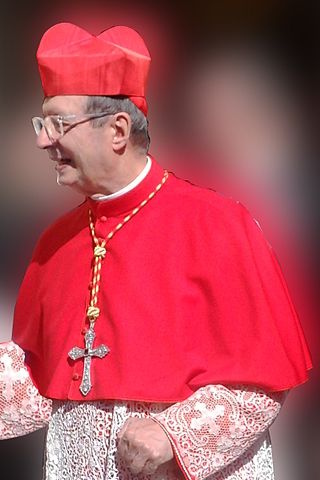Cardinal Cross

First, a quick recap on where the word cardinal comes from.
Way back in the 14th century this adjective meant "chief, pivotal", stemming from the Latin cardinalis. If you visualise the pin (axis) of a door hinge then you have a clear idea of the word's original meaning.
Rotating 360° from a central axis we can move from facing to the front, to the right, to the back, and to the left. If we face north the corresponding compass points are north, east, south and west, and these are called 'cardinal points' or 'cardinal directions'.
That's not to mean 'opposing' directions; rather 'other' directions.
An extension of this has been made by astrologists for the four zodiacal signs marking the equinoxes and the solstices: Capricorn, Libra, Cancer and Aries.
For ancient and naïve observation of the heavens, astrology and philosophy went hand-in-hand. These cardinal points were extended to Plato's four cardinal virtues of justice, prudence, temperance and fortitude, and further adopted by Christians in the 13th century.
In nature and mathematics, and even in the humble colour wheel, cardinality turns out to be pretty widely used.
Catholic tradition
Just as a hinge is essential for a door to swing open, there are some essential people within each religion. Since the 12th century, such people in the Roman Catholic Church have been called cardinals.
They usually wear a Pectoral Cross, as seen in this photo of Giovanni Cardinal Lajolo in his scarlet cassock.
In line with their importance within the Church hierarchy, cardinals can use coats of arms, which are usually topped with a double-beamed cross. It is that design that we use for the cross featured at the top of this page.
The same design is also called Patriarchal Cross. However, since different churches have their own distinction between the roles and ecclesiastical seniority of cardinals and patriarchs, on this page at least we refer to the symbol as a Cardinal Cross.
The coat of arms shown here (top) is of Cardinal Jorge Bergoglio who, from 2001 to 2003, was the cardinal-priest of the Jesuit San Roberto Bellarmino. When he became pope in 2013, his emblem was modified so that the red cardinal's galero (hat) and cross were replaced by the traditional papal silver mitre and crossed keys.
Going back to the compass mentioned earlier, before GPS changed our lives, a humble strip of magnetised metal was used to tell us which way we should go. Sometimes obstacles prevent us going in a straight line so our actual heading may vary from the compass bearing … but we know our goal.
And the hinge pin? The cardinal's role is pivotal to the bearing of the Catholic Church. Sometimes obstacles prevent the Church from getting there in a straight line; obstacles such as financial constraints, politics, etc., most of which are manmade, but the cardinals (hopefully) know the Church's goal.
A cynic would say that a hinge pin does nothing; it's just there, standing still, whilst the hinge wings do all the work. The hinge pin would argue otherwise; saying that he is the anchor on which the hinge wings just flap about.
Whatever view you may have, you'll agree that the parts which make up the hinge are mutually dependent.
(Move your mouse over the birds if you don't get the joke. Or click here if your device has no mouse.)
Other crosses with a compass connection include the Baptismal, Barbee, Brunswick Star, Celtic, Chakana, Crosslet and Zia crosses in particular, and the Latin cross in general.
See 'cardinal points' in the Sun Cross
The Seven Heavenly Virtues combine the four cardinal virtues of prudence, justice, temperance, and fortitude with the three theological virtues of faith, hope, and charity.
In the 16th century an opposing set were named the Seven Cardinal Sins
The bright red of the cardinal's cassock was one reason the bright red Cardinalidae bird was so named, as was the cardinal tetra (Paracheirodon axelrodih).
Both species, like Cardinal Jorge Bergoglio, are from South America.
In the Roman Catholic Church, the title of patriarch was abandoned in 2006.

